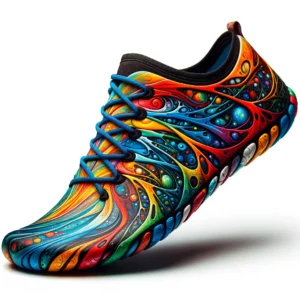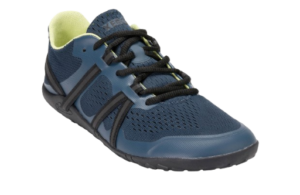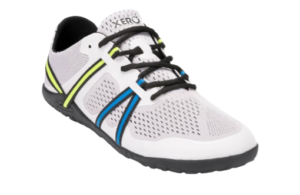The surge in popularity of barefoot shoes reflects a growing desire for a more natural and healthy approach to walking and running. As someone deeply knowledgeable about barefoot shoes, I can attest to the numerous advantages they offer.
Barefoot shoes are rooted in the belief that our feet are naturally designed to move without artificial interference. Traditional footwear with thick soles can hinder this natural movement, leading to posture issues and potential injuries. In contrast, barefoot shoes allow your feet to move freely and naturally, promoting better foot health by strengthening muscles and improving overall function.
One major benefit of wearing barefoot shoes is improved balance and stability. The thin sole provides a better sense of body position awareness, reducing the risk of falls during activities like hiking or trail running.
Additionally, these shoes encourage proper posture alignment by eliminating the unnatural forward tilt caused by elevated heels in traditional footwear. This reduces strain on joints from ankles up through hips, making them ideal for long walks or extended periods of standing.

In essence, understanding what makes a great pair of barefoot shoes will enable you to enjoy all its positive effects: improved foot health, enhanced balance, and stability, as well as superior posture alignment. Now let’s explore the key features that set exceptional barefoot shoes apart from the rest.
Key Features of the Best Barefoot Shoes
As someone with extensive experience in the world of barefoot shoes, I can confidently say that there are several key features you should look for when choosing the best pair. These features not only enhance your overall wearing experience but also ensure that you enjoy all the positive benefits of going barefoot.
- Minimalist Design: The best barefoot shoes boast a minimalist design, making them lightweight and flexible. This allows your feet to move naturally and freely, just like if you were walking or running barefoot.
- Wide Toe Box: A wide-toe box is one of the most desirable qualities in barefoot shoes as it provides ample room for your toes to spread out naturally, promoting better balance and stability while reducing foot pain.
- Thin Sole: Look for a thin sole in barefoot shoes as it enables better ground feel and sensory feedback, allowing you to connect with the terrain beneath your feet.
- Zero Drop: Barefoot shoes typically have zero drop or minimal heel-to-toe height differential, promoting a more natural gait pattern by eliminating elevation at the heel compared to the forefoot.
- Breathable Materials: Good ventilation is essential for activities like running or hiking so opt for barefoot shoes made from breathable materials such as mesh or perforated leather.
- Supportive Upper: While flexibility is crucial in barefoot shoes, having some level of support in the upper can be beneficial too. Look for models with overlays or straps that provide structure without compromising flexibility.
- Durable Outsole: Since many people use their barefoot shoes outdoors on various terrains, having a sturdy outsole is essential for longevity and protection against sharp objects.
- Easy Maintenance: Barefoot shoe maintenance should be hassle-free so look for models that are machine washable or can be easily wiped down with a damp cloth.
By considering these important factors when choosing your next pair of footwear, you’ll ensure an outstanding experience while reaping all the benefits of going around nature with barefoot shoes!
Top Barefoot Shoes in the Market
Looking for the perfect barefoot shoes? Look no further! We’ve curated a list of some of the best options on the market that offer a natural and minimalist experience for your feet. Here are our top picks:
-
Vivobarefoot Primus Lite III
This shoe is highly regarded among barefoot enthusiasts for its outstanding performance and comfort. With a wide toe box, it allows your toes to splay naturally while providing ample room for movement. Vivobarefoot Primus Lite III also offers excellent traction and durability, making it suitable for various activities such as running, walking, or casual wear.
-
Xero Shoes Prio
If you’re looking for an affordable yet high-quality option, the Xero Shoes Prio is worth considering. These shoes offer great flexibility and support without compromising on style. They feature a lightweight design with breathable mesh uppers that keep your feet cool during hot summer days.
-
Merrell Vapor Glove 4
Designed specifically for trail running, the Merrell Vapor Glove 4 provides exceptional grip and protection on rugged terrains while still allowing you to feel connected to the ground.
-
Lems Primal 2
Known for its comfortable fit and versatility, these shoes promote natural foot movement with their wide toe box and zero-drop platform.
-
Vibram FiveFingers V-Trail 2.0
For maximum ground feel and flexibility, Vibram FiveFingers V-Trail 2.0 is an ideal choice. The individual toe pockets allow each toe to move independently while providing excellent grip on both wet and dry surfaces.
Pros:
- All of these barefoot shoe options offer a wide-toe box
- They promote proper foot alignment
- Lightweight materials make them comfortable for extended wear
- Durable construction ensures long-lasting use
Cons:
- Some may find adjusting to the minimalist design takes time if they’re used to traditional footwear with more cushioning.
- It’s important to transition gradually into barefoot shoes to avoid discomfort or injury.
When choosing cool barefoot shoes, consider factors such as intended use (running, walking), foot shape/size, and personal preferences regarding style/color. Try different brands/models until you find what suits your feet comfortably. Remember, everyone’s feet are unique, so research customer reviews and seek expert advice before purchasing!

Tips for Choosing the Perfect Barefoot Shoe
Selecting the right barefoot shoe is crucial to ensure a positive and enjoyable experience. Here are some key factors to consider when choosing your ideal pair:
- Purpose: Consider what activities you’ll be doing in your barefoot shoes, whether it’s running, walking, or other forms of exercise. Different shoes are designed for specific activities, so choose one that suits your needs.
- Fit: Proper fit is essential for barefoot shoes – they should feel snug but comfortable without any tightness or pressure points. Look for brands that offer a wide range of sizes and widths to accommodate different foot shapes.
- Transitioning from Regular Shoes: If you’re new to barefoot shoes, ease into them gradually by wearing them for short periods each day and increasing the duration as your feet adjust.
- Supportive Features: Some individuals may need additional support due to specific foot conditions or preferences. Look for models with minimal arch support if needed or removable insoles for customization.
- Material Quality: High-quality materials like breathable mesh uppers and flexible rubber outsoles contribute to durability and comfort.
- Brand Reputation: Research reputable brands known for producing top-notch barefoot shoes with positive customer reviews within the community.
- Price Range: Consider your budget while keeping in mind that investing in quality footwear pays off over time due to longevity and performance benefits.
- Try Before You Buy: Whenever possible, try on the shoes before purchasing to assess their fit and comfort firsthand.
- Return Policies and Warranties: Check return policies and warranties offered by retailers or manufacturers so you can exchange or return the shoes if necessary.
Remember that finding the perfect barefoot shoe is a personal journey based on individual preferences – take your time exploring options, consulting experts if needed, and trusting your instincts when making a final decision.
Frequently Asked Questions about Barefoot Shoes
As an expert in barefoot shoes, I understand that there may be some common questions and misconceptions surrounding this unique footwear. In this section, I will address the most frequently asked questions and provide valuable insights to help you make the most out of your barefoot shoe experience.
-
What are barefoot shoes?
Barefoot shoes are a type of footwear designed to mimic the feeling of walking or running barefoot while still protecting your feet. They have minimal cushioning, zero-drop soles (meaning no height difference between the heel and toe), and a wide toe box that allows your toes to splay naturally.
-
Are barefoot shoes good for my feet?
Absolutely! Barefoot shoes offer numerous benefits for foot health. By allowing your feet to move more naturally, they can help strengthen muscles in your feet and lower legs, improve balance and posture, promote better proprioception (awareness of body position), and enhance overall foot function.

-
Can I use barefoot shoes for running?
Yes! Many runners have transitioned to using barefoot shoes as they encourage a more natural running gait with less impact on joints. However, it’s important to note that transitioning from traditional running shoes to barefoot ones should be done gradually to allow your body time to adjust.
-
How do I choose the right size of barefoot shoe?
Selecting the right size is crucial when it comes to choosing a pair of barefoot shoes. Start by measuring both feet as sizes can vary between brands. Look for sizing charts provided by manufacturers or consult customer reviews for guidance on whether a particular model runs large or small.
-
How do I transition from regular shoes to wearing barefoot shoes?
Transitioning from regular footwear requires patience and gradual adaptation when switching over to wearing minimalist footwear like barefoot shoes. Begin by incorporating short periods of wear into your daily routine before gradually increasing the duration over several weeks or months.
-
Can I wear these types, especially during summer?
Absolutely! These types are versatile enough to be enjoyed all year round, but they are especially comfortable and sturdy for outdoor activities such as hiking or walking in parks during the summer.
-
Where can I buy authentic pairs?
To ensure you’re purchasing genuine products, it’s best recommended to buy directly from their official website. Some popular brands known include Vivobarefoot, Xero Shoes, Groundies, and Merrell.
-
What should I look out for in return policies?
When buying any kind online, it’s essential to check what kind of return policy is offered by the seller/manufacturer. Look for generous windows that allow you to try them at home and assess the fit before making a final decision.
By addressing these frequently asked questions about barefoot shoes, I hope to have provided valuable insights into this unique category. Remember that wearing these types of shoes is not only beneficial but also an enjoyable experience that promotes healthy foot function with confidence.
Where to Buy the Best Barefoot Shoes
As an expert in barefoot shoes, I’m here to clear up any confusion and provide you with the best advice on how to make the most of these fantastic footwear options. Let’s dive into some of the most common questions about barefoot shoes.
-
What exactly are barefoot shoes?
Barefoot shoes are a type of minimalist footwear that aims to replicate the feeling of walking or running barefoot while still offering protection for your feet. They feature thin soles, zero-drop platforms (meaning no height difference between the heel and toe), and wide toe boxes that allow your toes to move naturally.
-
Are barefoot shoes good for my feet?
Absolutely! Barefoot shoes offer a multitude of benefits for foot health. By allowing your feet to move more naturally, they can help strengthen muscles, improve balance and posture, increase sensory feedback from the ground, and promote better overall foot function.
-
Can I use barefoot shoes for running?
Definitely! Many runners find that transitioning to barefoot or minimalist running can enhance their form and reduce injuries. However, it’s important to start slowly and gradually increase mileage to give your body time to adjust.
-
How do I choose the right size of barefoot shoe?
When selecting a pair of barefoot shoes, it’s crucial not only to consider length but also width and volume measurements. Different brands may have different sizing charts, so always refer to their specific guidelines before making a purchase.
-
How do I transition from regular shoes to wearing barefoot?
Transitioning from traditional cushioned or supportive footwear requires patience and gradual adaptation. Start by incorporating short periods of wear into your daily routine while listening closely to your body’s signals. Increase usage over time as you build strength in your feet and lower legs.
-
Can I wear barefoot shoes, especially during summer?
Absolutely! Barefoot shoes are versatile enough to be enjoyed all year round, but they are particularly comfortable and sturdy for outdoor activities such as hiking or walking in parks during the summer.

-
Where can I buy authentic barefoot shoes?
To ensure you’re purchasing genuine barefoot shoes, it’s best to buy from reputable retailers or directly from the brand’s official website. Avoid third-party sellers with questionable authenticity.
-
What should I look for in a return policy or warranty when buying barefoot shoes?
When shopping for barefoot shoes, consider the return policy and warranty offered by the retailer or brand. Look for great return windows and clear guidelines on returns/exchanges in case the fit isn’t right or if there are any defects in workmanship.
By addressing these frequently asked questions about barefoot shoes, I hope to have provided valuable insights into this unique category of footwear. Remember to always prioritize comfort and listen to your body as you embark on your journey towards healthier feet with these amazing minimalist shoes.
What features should I look for in good barefoot shoes to prevent injuries?
Good barefoot shoes should have a wide toe box to allow natural toe spread, thin and flexible soles for proper ground feedback, zero-drop from heel to toe for natural posture, and durable materials that protect the feet while allowing them to move as if they were barefoot.
Are there specific types of barefoot shoes recommended for people prone to foot injuries?
Yes, individuals prone to foot injuries may benefit from barefoot shoes with additional features such as a bit more cushioning without compromising ground feel, strong upper materials for protection, and perhaps some minimal arch support if transitioning from traditional footwear.
How do warranties typically work for barefoot shoes regarding potential defects or premature wear?
Warranties on barefoot shoes usually cover manufacturing defects and sometimes premature wear within a specified period. Customers need to keep their purchase receipt and contact the manufacturer or retailer according to their warranty policy instructions if an issue arises.
What is the expected volume capacity of good barefoot shoes, and how does it affect foot health?
The volume capacity of good barefoot shoes should accommodate the natural expansion of the foot under load without constriction. This means ample room vertically and horizontally that supports healthy circulation and allows muscles and tendons in the foot to function without restriction.
Can I get a replacement pair of barefoot shoes under warranty if they don’t fit well or cause discomfort due to improper sizing or volume issues?
Warranty policies typically do not cover returns or exchanges due to incorrect sizing or personal discomfort unless there is a defect involved. Most companies will have a separate return policy where unworn shoes can be exchanged or returned within a certain timeframe. however, it’s important to check individual store policies before purchasing.

